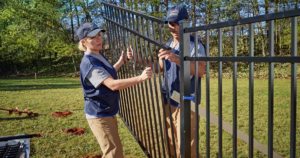SEO Services The Woodlands requires time, energy, and patience. However, a well-developed SEO strategy can yield great results and drive traffic to your website.
Webpages and their content are what search engines like Google index to determine if they’re relevant for a particular query. To maximize your SEO, keep in mind the following fundamentals:

Keyword research is the process of discovering and analyzing relevant search terms for your business. It is a critical step in any SEO strategy and the foundation of organic visibility.
During the keyword research process, marketers should consider their audience’s search intent and how they will use the keywords to find their products or services. This will help them prioritize and focus their content creation efforts.
As part of the keyword research, marketers should analyze the competition to understand how difficult it will be for them to rank for a particular term. This will be reflected in the “Keyword Difficulty” metric in popular SEO software tools like Semrush. However, it is important to remember that this metric is only one piece of the puzzle and it should not be used as the sole deciding factor on which keywords to target.
In addition to considering search intent, marketers should also analyze the search volume of each keyword. This will help them determine if there is sufficient demand for the keyword and will be an indication of how likely it will be to convert into traffic and customers. As a general rule of thumb, marketers should begin with low to mid-range search volume keywords and work their way up to higher volume and more competitive terms as they become more comfortable with the keyword research process.
A solid keyword research process will also uncover new opportunities that may not have been considered previously. This can be a great source of inspiration for new content assets such as blog posts, videos and guides. These can help you reach additional segments of your audience and increase the likelihood of conversions.
SEO has evolved a lot over the years and it is no longer enough to create a website or blog and optimize it for a few keywords. Instead, it is necessary to develop a complete digital strategy that encompasses all aspects of online marketing. This includes keyword research, content marketing, on-page optimization and off-page optimization. With a comprehensive approach, you can ensure that your brand has visibility and traffic at all times.
On-Page Optimization
Search engines use algorithms to crawl the web and understand what each page is about. The best way to optimize pages for these algorithms is on-page optimization, a process of optimizing front-end and back-end components on a webpage to tell search engines what the content is about and how it fits with relevant search queries.
On-page optimization requires an understanding of HTML, the language that websites are written in. This includes elements like the header> and h1> tags which allow you to create headings that are easily understood by both readers and search engines, as well as the p> tag which allows you to place a paragraph of text in your HTML.
Aside from these structural elements, on-page SEO also focuses on how words are used within your content. This can be as simple as placing your keyword in your title tag and meta description, or as complex as writing unique and informative page copy that helps search engines find you as a valuable resource.
When optimizing your website’s on-page SEO, it’s important to remember that search engines are looking for relevance and user experience. Creating and publishing quality content is the only way to make sure your on-page SEO is working for you.
Title tags are a crucial part of on-page SEO, and are often the first thing searched for in Google. Ensure your page titles include your keywords and reflect the intent of the query, and that they’re accurate and descriptive. A well-written page title can increase click-through rates on search results pages by as much as 30%, so it’s a good idea to invest in this on-page SEO factor.
Meta descriptions are the short summaries that appear underneath a search result’s title, and while they aren’t a direct ranking factor for SEO, they can help influence click-through rates. Aim to keep your meta descriptions between 150 and 250 characters to prevent them from getting cut off in search results.
Other on-page SEO practices include using structured data and optimizing images. While these aren’t a direct ranking factor, they can impact your rankings by making it easier for search engine bots to understand the information on your page.
Off-Page Optimization
As its name suggests, off-page optimization focuses on factors that are outside of your control. This includes elements like building links and authority. In comparison, on-page SEO primarily involves optimizing elements within your website, such as content and keywords.
One of the most important aspects of off-page optimization is establishing your brand as an authority in your niche. This is accomplished through backlinks and other methods that show Google that your site is trustworthy and provides high-quality information. For example, having a backlink from a reputable source like Forbes or Business Insider indicates to search engines that your content is valuable and should be shown to users.
Another off-page factor is social media engagement. This can include interactions with your audience on Facebook and Twitter, as well as other platforms that are relevant to your niche. This type of engagement is a great way to establish trust and build awareness for your brand. It can also help to drive traffic to your website and build your audience.
Off-page optimization can also involve local SEO, which is the process of optimizing your website and online presence for search engine results in your geographical area. This can be done through backlinks, social signals, and local citations. One of the most important local citations is your Google Business Profile, which influences how you appear in SERPs and on Google Maps. This can be optimized by creating and optimizing your GBP, as well as by claiming and optimizing other Google business listings like Bing Local and Yelp.
It’s important to note that off-page optimization can be influenced by virtually every marketing communications tactic your team uses, and it should be a holistic approach. Regardless of the specific tactics you employ, it’s the responsibility of the SEO specialist to champion off-page factors within the wider marketing department.
It’s also worth mentioning that off-page optimization is essential for meeting many of the Quality Rater Guidelines set by Google, specifically E-E-A (Experience, Expertise, Authoritativeness, and Trustworthiness). While it is true that your website can’t achieve these goals with on-page optimization alone, you will not have success without strong off-page SEO.
Link Building
In order to improve the visibility of a website or individual webpages on search engines, SEO practitioners employ many different tactics and strategies. One such strategy is link building, which involves acquiring links from other websites to point to your own site. Link building can be performed by both search engine optimizers and businesses, and it’s often a key part of digital marketing campaigns.
In general, the best links are those that are relevant to your business and topic and that appear natural. However, there are also a number of other factors to consider when performing link building, including anchor text, link authority, and the quality of the website linking to yours.
A link’s anchor text refers to the visible text of a link, and in most cases, you want to use keywords in your anchor text. This is because studies have shown that using keywords in your anchor text leads to higher rankings for those words in search results. However, be careful not to overdo it, as Google penalizes sites that use “spammy” anchor text, and using too many keyword-rich phrases can actually hurt your ranking.
There are a variety of methods you can use to build links, such as posting to forums and communities, contributing to other blogs, and guest blogging. These techniques are generally considered to be “white hat” link building, meaning they’re in line with Google’s guidelines and don’t try to manipulate search engine rankings. There are also black-hat link-building techniques, such as buying links or participating in link exchanges, which are against Google’s guidelines and can potentially get your site banned from search results.
Other good link-building practices include creating resource pages on your website and promoting them via social media. These types of links are considered to be high-quality because they’re created in the form of a useful guide or resource on a topic that readers will find valuable. In addition, these types of links tend to have a high domain rating, which is a metric provided by Ahrefs.




